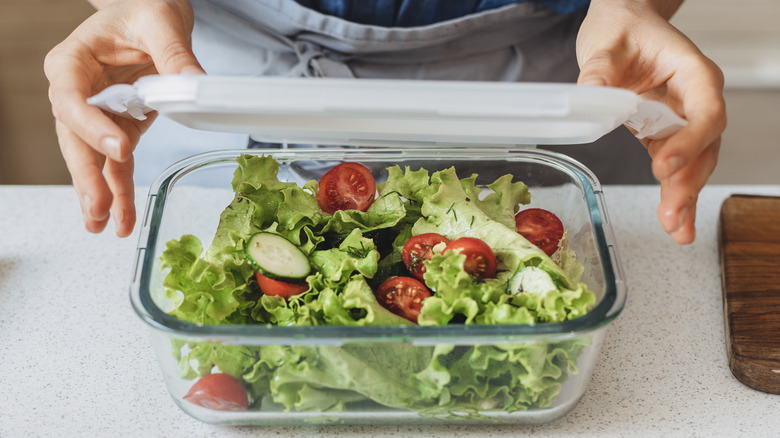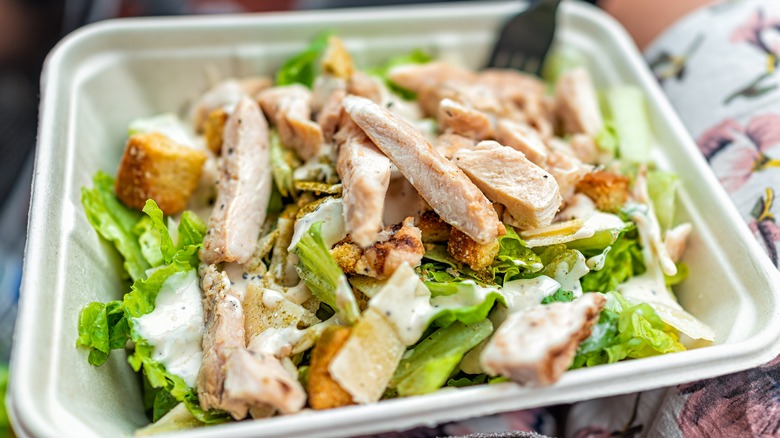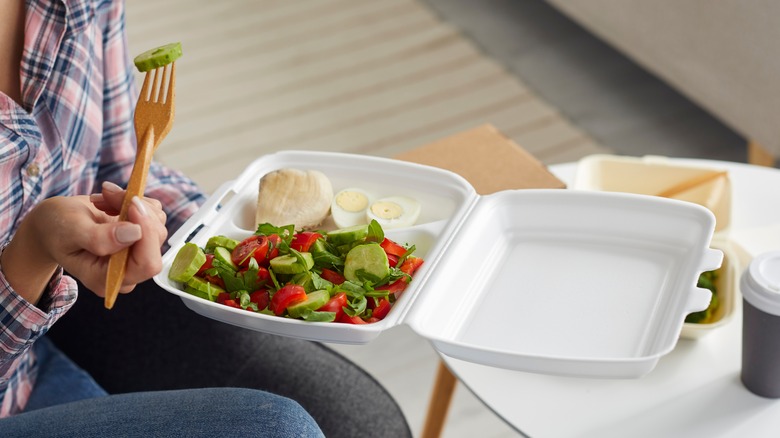The Hydrating Benefit Of Your Lunchtime Salad
It is essential to frequently replenish your water intake to avoid dehydration. Common wisdom tells us that eight cups of water a day is sufficient, but the actual amount you need is probably higher and varies according to body weight, physical activity, weather, and other factors. According to the Mayo Clinic, daily water needs are closer to 11.5 cups for women and 15.5 cups for men. That's a lot to drink in a day, but thankfully, water from food can supply up to 20% of your hydration needs. Surprisingly, your lunchtime salad is loaded with hydrating ingredients. Lettuce is one of the best foods to boost hydration due to its high water content — especially romaine and iceberg.
While iceberg does not supply as many nutrients as other lettuces, it does vie for top of the list of most hydrating foods. It ranks number two with a whopping makeup of 96% water content. On the other hand, romaine lettuce is packed with vitamins and minerals, and it too is impressively hydrating, ranking number five with 95% water content. Including either of these in your salad is an effortless way to get hydrated while on your lunch break.
Even mild dehydration can have serious consequences, including cramping and heart irregularities. Severe dehydration is a dangerous condition that can result in heat stroke, seizures, kidney damage, and may lead to brain damage or death (via Cedars Sinai). You can avoid dehydration by drinking water and other fluids, but you can also try eating hydrating foods.
Have your water and eat it too
Iceberg lettuce usually gets the short shrift. Take, for example, this quote by chef Marcus Samuelsson: "Salad can get a bad rap. People think of bland and watery iceberg lettuce, but in fact, salads are an art form," per Huffington Post. Of the different types of lettuce, iceberg may not be the most exciting, but its hydrating quality is why we shouldn't dismiss it outright. Mix it with more nutritious kinds of lettuce to take advantage of its juicy goodness. Iceberg's slightly sweet flavor is a nice balance to the earthiness of other greens, and its crunchy texture is lovely in even the fanciest of salads, or by the wedge, drizzled in blue cheese.
Despite its bland reputation, iceberg isn't entirely devoid of nutrients. It has beneficial levels of vitamins A, B9 (folate), and K, and minerals calcium, potassium, phosphorus, and sodium – all electrolytes that regulate body fluids. Put simply, iceberg lettuce has water your body needs, and the components to help you utilize it.
Unlike iceberg, romaine lettuce has a robust nutritional profile to go with its abundant water. This dark, leafy green is high in vitamins A, B9, C, and K, and is a good source of calcium, fiber, iron, and potassium. Best known as the main ingredient in Caesar salad, romaine is sturdy enough to stand up to heat; you can use just the hearts or the whole head in a grilled romaine salad. Make it beforehand for a delicious, hydrating next-day lunch.
Water, water, everywhere
A great thing about salads is that you can build a healthy meal from the ground up, full of all the most hydrating ingredients. The crunch of iceberg lettuce and mild bitterness of romaine go perfectly with other water-heavy vegetables. Cucumber tops the list at number one by having more water content than any other food, coming in at nearly 96% – it's practically all water. Celery comes in just below with a hefty 95%. Zucchini squash ranks right up there too, with more than 92% water. Slice it thin with a mandolin or use a spiralizer to make hydrating zoodles, aka, raw zucchini pasta.
Like tasty, tangy water bombs, tomatoes contain almost 95% water – that's actually more hydrating than watermelon! Along with all that water, tomatoes are also a nutritional powerhouse chock full of vitamins and minerals, including vitamins A (beta carotene), B9, C, K, and potassium. Tomatoes are also a primary food source of the powerful antioxidant lycopene. A 2014 report published in the journal Nutrients concludes that lycopene may significantly reduce the risk of some chronic diseases.
For an incredibly healthy lunchtime salad that brings together the topmost hydrating foods, put together a blend of romaine leaves and iceberg lettuce, zucchini spirals, chopped cucumber, celery, tomatoes, plus any of your favorite salad toppings. Optionally, you can add some protein, like beans, eggs, or grilled chicken, then combine everything with an herb-infused homemade salad dressing. Fresh and filling, fluid-forward salads will leave you feeling satisfied and replenished.



